Drfees
The Media Specialist Handbook
Youtube. Fighting Plagiarism. This article will focus on the importance of structuring research projects so they require original thought.
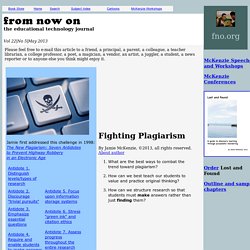
The student will not just find an answer. The student will build an answer.
Fighting Plagiarism. Videos. One of the best ways to learn about Creative Commons is to watch one of our videos. What is Creative Commons? From our friends at Wikimedia, a short video describing Creative Commons licenses. CC:Rewire A video from our big CC:Rewire event in San Francisco in June, 2016. When we share, everyone wins. Getting Started with Primary Sources
If you can see or hear the materials on the Library of Congress website, you may view or listen to them on the site.
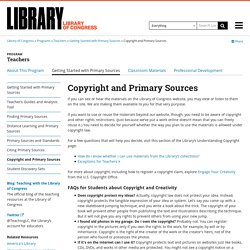
We are making them available to you for that very purpose. If you want to use or reuse the materials beyond our website, though, you need to be aware of copyright and other rights restrictions. (Just because we’ve put a work online doesn’t mean that you can freely reuse it.)
Copyright Advisory Network - Copyright Advisory Network. Copyright Kids!
Copyright. Youtube. Copyright for Educators. Copyright for Educators is a series of videos designed to help educators learn about what they can and can't do within the category of "Teaching" in the Copyright Act.

Under the Copyright Act, there is nothing more intriguing and exciting for educators than Fair Use. Fair Use is the concept that if you are doing something for the greater good of society, like teaching, then your needs supersede the ownership rights of the copyright holder under the Copyright Act.
5-Minute Film Festival: Copyright and Fair Use for Educators. I absolutely love it when teachers and students create, remix, and mash up media; it's a fantastic way to encourage deeper learning and media literacy.

But one issue that complicates digital freedom of expression is copyright law. While many would argue that copyright law is outdated and badly in need of an overhaul, it's still critical that adults and kids alike have a basic understanding of what's legal and ethical while playing with other people's intellectual property. Here's a list of videos I collected to help you navigate the murky waters of copyright law in educational settings.
FairUse MythsFacts 27FEB2015.
How to Find Public Domain and Creative Commons Images. In last week's survey of Free Technology for Teachers readersFlickr The Commons, Photos for Class, and Pixabay were chosen as the best places to find public domain and Creative Commons images.
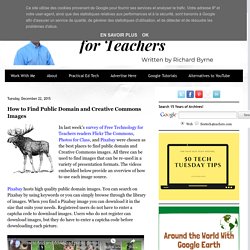
All three can be used to find images that can be re-used in a variety of presentation formats. The videos embedded below provide an overview of how to use each image source.
The Four Factors of Fair Use. Circ21. Excellent Video Tutorials for Teachers and Students to Learn about Copyright and Common Sense. Copyright Explained For Students: Don’t Get Caught Out - Digital.com. The Internet has brought the issue of copyright to the forefront like nothing else in history.
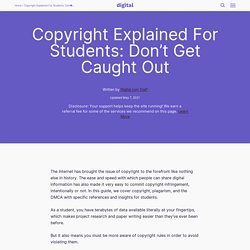
The ease and speed with which people can share digital information has also made it very easy to commit copyright infringement, intentionally or not. In this guide, we cover copyright, plagarism, and the DMCA with specific references and insights for students. As a student, you have terabytes of data available literally at your fingertips, which makes project research and paper writing easier than they’ve ever been before. But it also means you must be more aware of copyright rules in order to avoid violating them.
Backgroundknowledge. 50 Ways to Use Picture Books w ELA Students Final Handout. 10 Tips to Create Great Readers. Great readers are made; they are not born (to paraphrase Vince Lombardi).
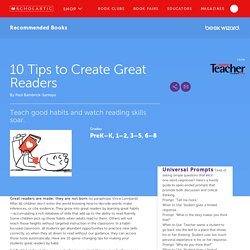
After all, children don’t enter the world knowing how to decode words, make inferences, or cite evidence. They grow into great readers by learning great habits—accumulating a rich database of skills that add up to the ability to read fluently. Some children pick up those habits when adults read to them. Others will not reach those heights without targeted instruction in the classroom. In a habit-focused classroom, all students get abundant opportunities to practice new skills correctly, so when they sit down to read without our guidance, they can access those tools automatically.
Watch. Connect. Read.
Selected Articles AR. 5 Free Tools for Creating Book Trailer Videos. The traditional book report that asks students to critique the books that they read is a staple of many classrooms.
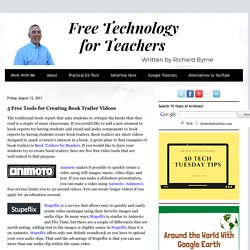
If you would like to add a new element to book reports try having students add visual and audio components to book reports by having students create book trailers. Book trailers are short videos designed to spark a viewer's interest in a book. A great place to find examples of book trailers is Book Trailers for Readers. If you would like to have your students try to create book trailers, here are five free video tools that are well-suited to that purpose.
7 Tips for Successful Collaboration. Who We Are and What We Do We are National Board Certified Teachers who have been collaborative partners for almost a decade at Oceanside High School in New York.
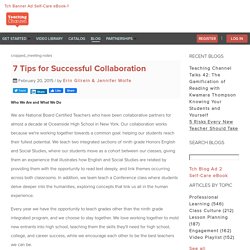
Our collaboration works because we're working together towards a common goal: helping our students reach their fullest potential. We teach two integrated sections of ninth grade Honors English and Social Studies, where our students move as a cohort between our classes, giving them an experience that illustrates how English and Social Studies are related by providing them with the opportunity to read text deeply, and link themes occurring across both classrooms. In addition, we team teach a Conference class where students delve deeper into the humanities, exploring concepts that link us all in the human experience.
S.O.S. for Information Literacy. Collaboration is an evolving process that does not happen overnight.
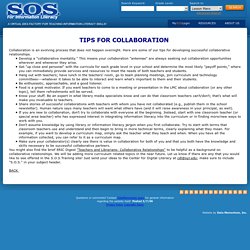
Here are some of our tips for developing successful collaborative relationships. Develop a "collaborative mentality.
" This means your collaboration "antennae" are always seeking out collaboration opportunities wherever and whenever they arise.Get "up close and personal" with the curricula for each grade level in your school and determine the most likely "payoff points," where you can immediately provide services and resources to meet the needs of both teachers and students.Hang out with teachers; have lunch in the teachers' room, go to team planning meetings, join curriculum and technology committees---whatever it takes to be able to interact and learn what's important to them and their students.Be enthusiastic, approachable, and a good listener.
Teacher-Librarian Collaborative Inquiry Project... by Johanna Gibson-Lawler. How to Create Fruitful Co-Teaching Partnerships. A MiddleWeb Bog By now co-teachers around the nation have had a chance to get off on the right foot. I hope you had a flying start!
For Teachers - Teachers Connecting with Teacher Librarians. Cybraryman Internet Catalogue. What Is Differentiated Instruction? - ASCD Inservice. So, how would you define differentiated instruction?
In her newly revised book, The Differentiated Classroom: Responding to the Needs of All Learners, 2nd Edition, Carol Ann Tomlinson discusses the meaning of differentiation and how teachers can modify their instruction to engage all students. The book highlights key principles of differentiation, including: An invitational learning environment that encourages and supports learningQuality curriculumAssessment that informs teaching and learningInstruction that responds to student variance Take a look at the infographic below that highlights some of the best and worst practices for differentiation in today’s classrooms. Post it in your office and share it with your colleagues as a reminder to refine your teaching strategies to meet the learning styles of all students.
Differentiation – For the Teachers. Differentiation is adjusting and modifying what skills and concepts students learn, what materials they use, and/or how their learning is assessed based on the needs of the students. Our students are not all the same, so we cannot expect that teaching a lesson in one way will reach every student. Our students are unique individuals with their own prior learning and their own learning preferences. An effective teacher makes the changes needed to reach every student where they are and to guide them to an understanding of the skills and concepts we want them to learn.
To Teach Students First. Historical Meets Hysterical In a unit on late 19th-century nationalism, and at the suggestion of a student, we decided as a class to put on our version of The Colbert Report under the guise of different European countries going through nationalist development at that time. Students broke up into different country groups and planned their versions of The Colbert Report, incorporating appropriate and relevant content with interesting twists and segments akin to Colbert's flow and structure, which at that time was extremely popular with students. The level of engagement was high, the desire for performance was evident, and collaboration was a necessity.
Association for Library Service to Children (ALSC)
Student Self-Assessment Practices That Work (Opinion)
The One-Right-Answer-Mentality (Part Two)
7 Tips for Successful Collaboration. What is Authentic Assessment?
The Best Value in Formative Assessment. Make Formative Assessment More Student-Centered. Fantastic Comprehensive List of Assessment Tools for Teachers - EdTechReview. Library Girl's Picks: The Best Digital Tools for Formative Assessment. The Best Value in Formative Assessment. 15 Good Tools for Quickly Gathering Feedback from Students.
ASSESSMENT DOWNLOADS – TRAILS Archive. 10 Quick Assessments You Can Perform In 90 Seconds. Seven Keys to Effective Feedback. Why Check for Understanding?
Balancing Approaches for PBL Success. 10 Practical Ideas For Better Project-Based Learning In Your Classroom. Flip This Library: School Libraries Need a Revolution. 10 Edtech Tools for the Flipped Classroom. Youtube. Youtube. StriplingModelInquiry. 10 Quick Assessments You Can Perform In 90 Seconds. Icts-sc / The Simple Four. Overview Big6 by the Month, Aug. 22, 7-8 pm Eastern 8-22-13 7.03 PM. Research Process Livebinder USC-SLIS 742.
ANTHILL nmemonic for research process. Building Good Search Skills: What Students Need to Know. Common Core in Action: 10 Visual Literacy Strategies. Harnessing Students’ Curiosity to Drive Learning. Designing Inquiry Based Science Units As Collaborative Partners Okemura. Information Specialist and Leader Collection and Curriculum Mapping Howard. Use Standards to Draw Curriculum Maps (Franklin)
How to Use Curriculum Mapping - TeachHUB. Professional Development.
ASCD: Professional Learning & Community for Educators. Why we need qualified teacher librarians for the digital future — Kinderling Kids Radio — music for children and families. Why are school libraries essential?
School Libraries Work!
S.O.S. for Information Literacy. School Libraries Fight Fake News. Schoollibrarianmindset. Learning Posters - the LIIITE Model. Ten Things Your Administrator Needs to Know as the School Year Begins.
Instructional digital tools and websites










